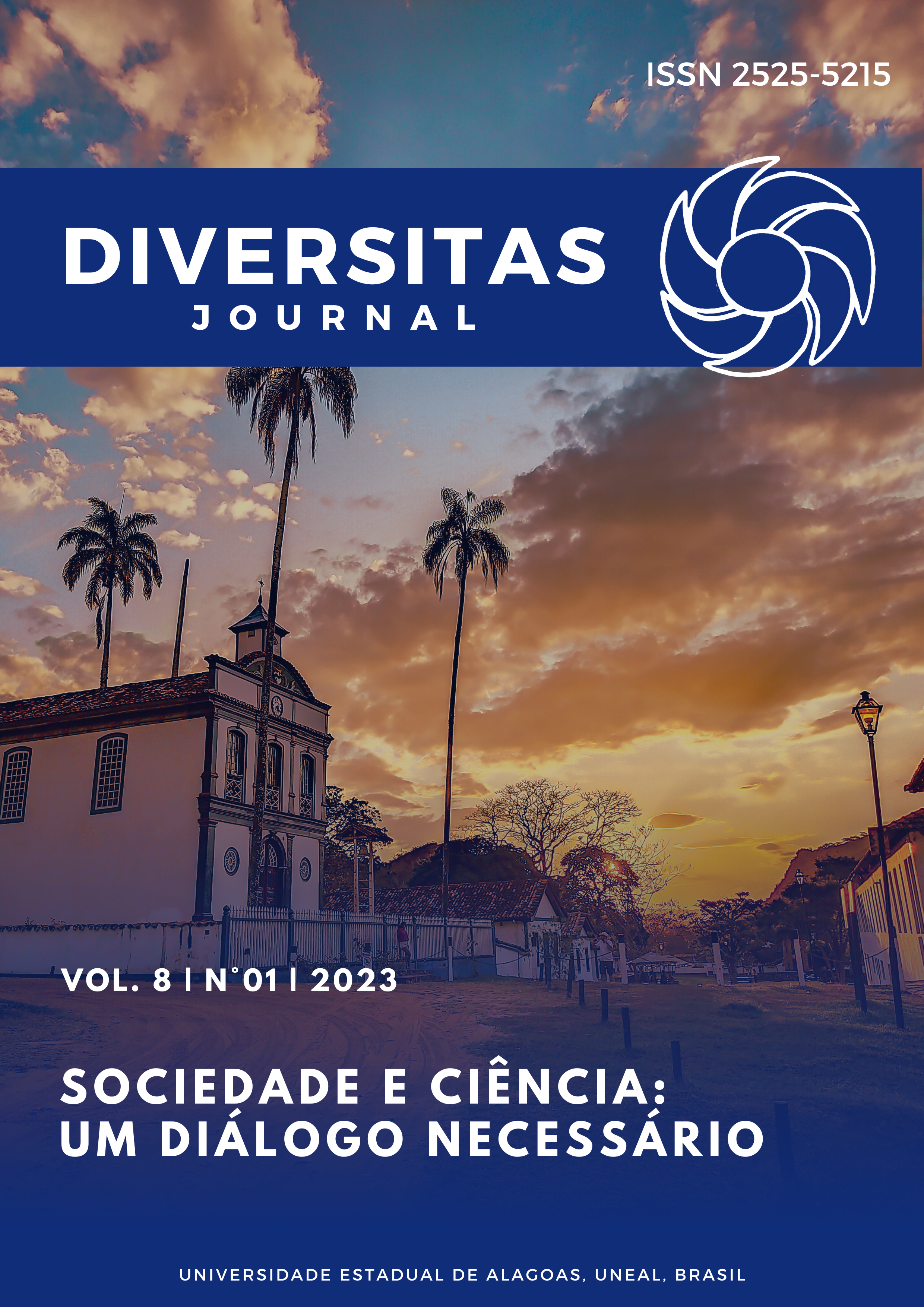Uso de Geotecnologias para regularização ambiental de propriedades rurais
DOI:
https://doi.org/10.48017/dj.v8i1.2402Keywords:
geotechnologies, forest code, environmental regularizationAbstract
Considering that the current Brazilian Forest Code (Law No. 12.651/2012), among Brazilian laws, regulates the conservation of natural resources in relation to activities carried out on rural properties, determining the percentages for Permanent Preservation Areas (APP) and Legal Reserve areas (RL), the objective work to be used the QGIS Software as a tool for studies aimed at regularization rural properties to this law. Among the tools and applicability, visualization, mapping and calculation of areas based on georeferenced data were used to show the viability of environmental regularization and present mitigating measures that must be established in the study area, aiming at reducing the effects from environmental impacts negative. The regularization of the Farm Dois Irmãos das Bicas property under the Forest Law nº 12.651/2012, took into account the framing of the areas of RL, APP and Consolidated Activity (AC) to what determines the norms of the legislation. The percentages of land use and occupation destined for the AC and RL areas comply with what is established by law: respectively 67.58% of the land cover of the property is used for agriculture, which is fully adequate to the percentage established by law (up to 80%). The total of 27.17% is preserved, contemplating the minimum value of 20% destined to the occupation of remaining native vegetation as RL. The APP covers about 22.3 hectares with the presence of native species. For the APP to comply with the legislation, the Farm will need to restore three hectares with regionalized native species of the Atlantic Forest.
Metrics
References
Alexandrino, R., Silva, F., Falcão Filho, C. A., & Galindo, J. R. (2013). Aplicações de geotecnologias gratuitas na adequação de propriedades rurais a legislação ambiental. Enciclopédia Biosfera, 9 (17). https://www.conhecer.org.br/enciclop/2013b/MULTIDISCIPLINAR/Aplicacoes%20de%20Geo.pdf
Andrade Netto, D. S. (Coord.). (2015, junho). Cartilha de restauração florestal de áreas de preservação permanente, Alto Teles Pires, MT. The Nature Conservancy & LERF. http://www.lerf.eco.br/img/publicacoes/TNC_Cartilha_MT_INTERATIVO_17-9-2015.pdf
Andrade, V. L. (2018). A legislação brasileira e a fragmentação de ecossistemas: observações pontuais a partir das paisagens dos Distritos do Parque Durval de Barros e Sede Municipal, Ibirité-MG1. Conteúdo Jurídico. (877), pp. 217-253. http://www.conteudojuridico.com.br/open-pdf/cj591315.pdf/consult/cj591315.pdf
Aquino, F. G. & Albuquerque, L. B. (2010, 02 de março). Reserva legal: benefícios econômicos e ambientais. Jornal Dia de Campo. http://www.diadecampo.com.br/zpublisher/materias/Newsletter.asp?id=21266&secao=Artigos%20Esp.
Attanasio, C. M., Rodrigues, R. R., Gandolfi, S., & Nave, A. G. (2006, julho). Adequação ambiental de propriedades rurais recuperação de áreas degradadas restauração de matas ciliares. [Universidade de São Paulo]. Departamento de Ciências Biológicas. http://arquivos.ambiente.sp.gov.br/municipioverdeazul/2011/11/AdequacaoAmbientalPropiedadesRurais.pdf
Brancalion, P. H. S., Gandolfi, S., & Rodrigues, R. R. (2015). Restauração Florestal. Oficina de Textos. p. 14-39.
Capeche, C. L. (2012). Impactos das queimadas na qualidade do solo-degradação ambiental e manejo e conservação do solo e água. II Encontro Científico do Parque Estadual dos Três Picos. https://www.embrapa.br/busca-de-publicacoes/-/publicacao/956695/impactos-das-queimadas-na-qualidade-do-solo---degradacao-ambiental-e-manejo-e-conservacao-do-solo-e-agua
Companhia Nacional de Abastecimento. (2020). Acompanhamento da safra brasileira de cana-de-açúcar. https://www.conab.gov.br/ultimas-noticias/3568-conab-estima-producao-estavel-de-cana-e-forte-destaque-para-o-acucar-na-safra-atual
Empresa Brasileira de Pesquisa Agropecuária – Embrapa. (s.d.). Código Florestal: adequação ambiental da paisagem rural. https://www.embrapa.br/codigo-florestal/entenda-o-codigo-florestal/perguntas-e-respostas
EngeSat. (s.d.). http://www.engesat.com.br/imagem-de-satelite/planetscope.
Köppen, William. (1931). Climatologia. Fundo de Cultura Econômica.
Lei nº 12.651, de 25 de maio de 2012 da Presidência da República. Casa Civil. Subchefia para Assuntos Jurídicos. (2012). Dispõe sobre a proteção da vegetação nativa; altera as Leis nºs 6.938, de 31 de agosto de 1981, 9.393, de 19 de dezembro de 1996, e 11.428, de 22 de dezembro de 2006; revoga as Leis nºs 4.771, de 15 de setembro de 1965, e 7.754, de 14 de abril de 1989, e a Medida Provisória nº 2.166-67, de 24 de agosto de 2001; e dá outras providências.
http://www.planalto.gov.br/ccivil_03/_Ato2011-2014/2012/Lei/L12651.htm#art83
Marques, L. (s.d). Qgis: Tudo que você precisa saber. Descomplica Qgis. https://descomplicaqgis.com.br/qgis-o-que-e-o-que-faz-e-para-que-serve.
Martins, A. F. (2011). Controle de gramíneas exóticas invasoras em área de restauração ecológica com plantio total, Floresta Estacional Semidecidual. [Dissertação de Mestrado - Escola Superior de Agricultura Luiz de Queiroz.]. Biblioteca Florestal. http://www.bibliotecaflorestal.ufv.br/handle/123456789/5773.
Okuyama, K. K., Rocha, C. H., Weirich Neto, P. H., Almeida, D., & Ribeiro, D. R. (2012). Adequação de propriedades rurais ao Código Florestal Brasileiro: estudo de caso no estado do Paraná. Revista Brasileira de Engenharia Agrícola e Ambiental, 16, p. 1015-1021. https://revistas.uepg.br/index.php/conexao/article/view/10070
Palma, V. H., Arco-Verde, M., Curcio, G., Galvão, F., & Mattos, L. (2020). Análise financeira de sistema agroflorestal (SAF) orgânico do sul do Brasil. Enciclopédia biosfera, 17 (31). https://conhecer.org.br/ojs/index.php/biosfera/article/view/73
Resolução CONAMA Nº 303/2002 do Ministério do Meio Ambiente. (2002). Dispõe sobre parâmetros, definições e limites de Áreas de Preservação Permanente. Data da legislação: 20/03/2002. Publicação DOU nº 090, de 13/05/2002, p. 68. Revoga a Resolução nº 04, de 1985. Alterada pela Resolução nº 341, de 2003.
http://www2.mma.gov.br/port/conama/legiabre.cfm?codlegi=299
Santos, S. S. dos. (2011, outubro). O cultivo da cana-de-açúcar no estado de Alagoas: uma análise comparativa dos efeitos da mecanização no estado de São Paulo. [Dissertação de Mestrado – Universidade de Brasília]. Centro de Desenvolvimento Sustentável. https://repositorio.unb.br/bitstream/10482/9843/3/2011_SergioSilvadosSantos.pdf
Downloads
Published
How to Cite
Issue
Section
License
Copyright (c) 2022 Débora Pimentel, Carlos Frederico Lins e Silva Brandão, Arthur Costa Falcão Tavares, Hilda Rafaella da Silva Santos, Ana Rosa de Oliveira Farias, Alana Thais de Lima

This work is licensed under a Creative Commons Attribution 4.0 International License.
The Diversitas Journal expresses that the articles are the sole responsibility of the Authors, who are familiar with Brazilian and international legislation.
Articles are peer-reviewed and care should be taken to warn of the possible incidence of plagiarism. However, plagiarism is an indisputable action by the authors.
The violation of copyright is a crime, provided for in article 184 of the Brazilian Penal Code: “Art. 184 Violating copyright and related rights: Penalty - detention, from 3 (three) months to 1 (one) year, or fine. § 1 If the violation consists of total or partial reproduction, for the purpose of direct or indirect profit, by any means or process, of intellectual work, interpretation, performance or phonogram, without the express authorization of the author, the performer, the producer , as the case may be, or whoever represents them: Penalty - imprisonment, from 2 (two) to 4 (four) years, and a fine. ”


















